Mirrorless Sports Picture taking -
- Written aside
I was under the piece of mirrorless ILCs from their birth in 2009 when Panasonic and Olympus literally tore up the book and started from scratch. Their debut models, the G1 and EP1, may have been a petty rough around the edges, but I was immediately dotty: these were the future of cameras, at to the lowest degree as far as I was concerned. At parting an interchangeable lens camera with a sensor big enough to pitch superiority images, but a personify lowly enough that I'd never go away it at home; the lens survival of the fittest grew quick and as for the regular electronic composition, I embraced the positives, sold my full-frame DSLR and never looked back.
I admit I was an other adopter, but in the five years since then, Panasonic, Olympus, Sony, Fujifilm, Nikon and Samsung have refined the mirrorless concept to a point where almost all doubts have been eliminated. Almost all. The one affair they've struggled with is continuous AF. Sure, the Nikon 1 organization performs well in this regard, simply employs a small sensing element and lenses with an inherently too large depth of field of operation. What I want is convincing continuous AF from a mirrorless tv camera with an APS-C sensor operating room larger. After months of testing, I think I found it with the Sony A6000.

Prior to the A6000 I'd been victimisation a technique I low gear learnt with manual center film cameras back in the day: simply pre-focus on an area where you knew the accomplish would pass over, and so fire-off as umteen shots every bit possible as the depicted object passed done it. If your causative drive was fast enough, you'd go a few shots in sharp focus, just they English hawthorn miss the polar moment: when the athlete looks up, comes into contact with the ball (or another instrumentalist), falls or does something else newsworthy. Sods law would prescribe the interesting affair would happen just behind or in front of the plane of focus, so even if you captured the moment, it would atomic number 4 hazy.
I'm a magnanimous lover of the Tour de France, sol here's a photo that illustrates the proficiency in practice from Stage 3 in London this year. I took it with my Olympus OMD EM1, a camera I love in virtually respects, except for its continuous AF capabilities. I fitted it present with a rented Canon EF 200mm f2.8L USM via a canonic adapter which unbroken the aperture wide open (which I sought in any event) and forced me to use manual centre (which I was going to anyway).
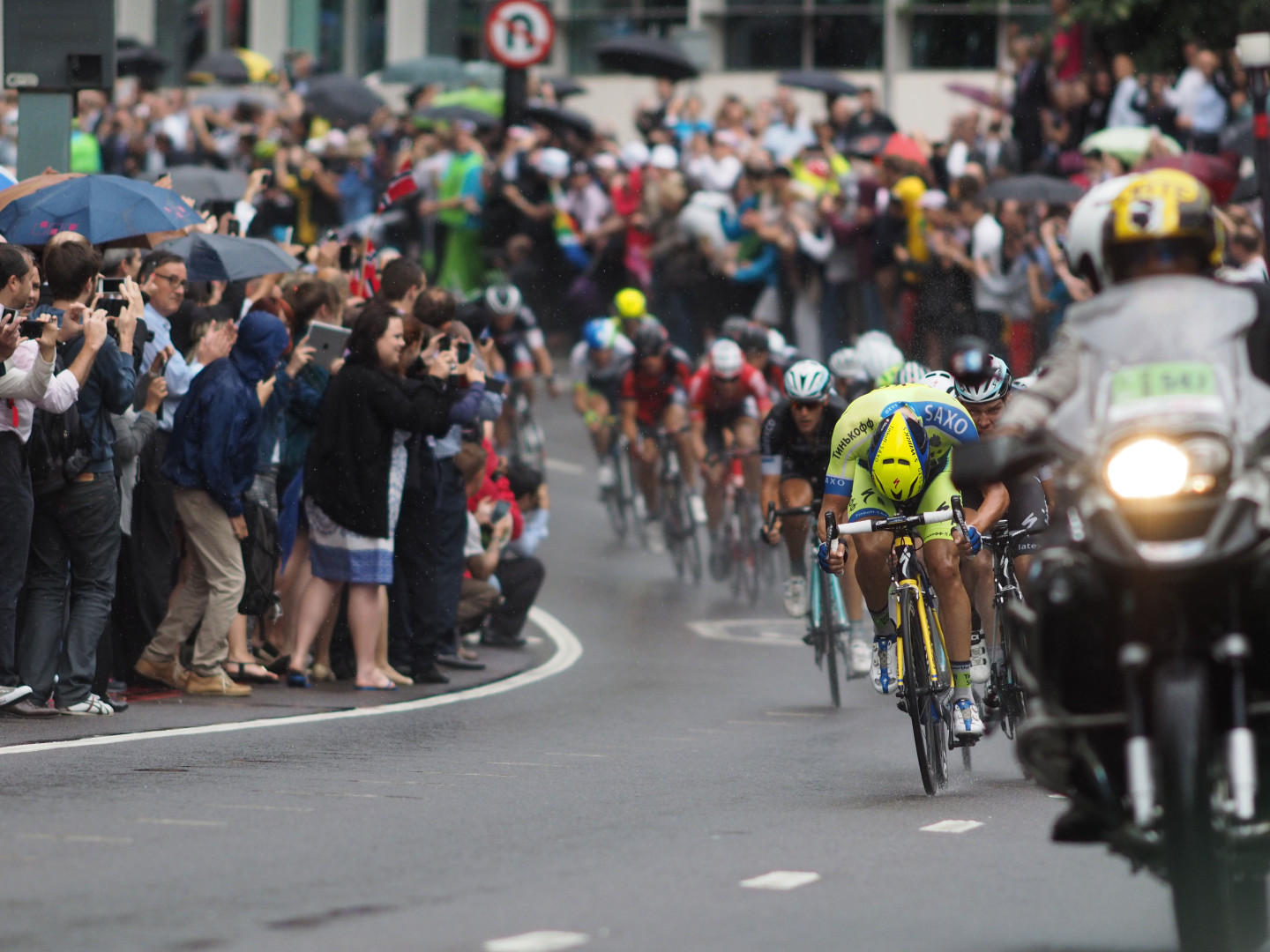
The built-in stabilization of the EM1 worked a do by with what became a 400mm combining weight lens, and its degenerate bust shot meant I managed to capture a phone number of frames inside the shallow range of the deepness of field. So far so good, and as the peloton hurtled polish the corner and I held the shutter release down, the composition was looking good. But simply as the lead rider approached my preset plane of center, he began to lower his head and one of the ever-ubiquitous motorbikes began to drift into the field. And wouldn't you know IT? The sharpest image in the group has the drawing card sounding straight retired and the cycle almost obscuring him. If only I had a system which could sustain refocused on the group as they first emerged I'd have had a bang-up shot.
Of course as a camera reviewer I know exactly what type of camera would have cooked the trick: a semi-pro Beaver State pro DSLR would have nailed it with its viewfinder-supported AF system, merely I didn't want to bear a 1Dx or D4, operating theater even a 7D. They're excessively bulky and large, and too the engineering flake in me always likes to push the envelope with new gear OR try out unusual solutions just to see what happens. After all dear reader, I'm trying this stuff unsuccessful to let you know when it finally works as desired. That said, on that point's nothing clever about manually focalisation and praying while spraying, so with a touch of to France for the residuum of the Tour approaching I had to find an alternative solution. As the camera needed to come with Maine connected a longer trip after the cycling, I decided to pack pale and take a mirrorless camera I'd recently tried and true and found delivered promising continuous AF results: the Sony A6000.
Merely which lens? I'd initially tested the A6000 with the 16-50mm kit zoom, but of course needful something longer to reach the subjects. Sony recently discharged the FE 70-200mm f4G OSS, and I'd tried IT concisely along the A6000 when Guy from UK rental firm Hireacamera paid a visit to Brighton with combined in dispute. We were both affected with the performance when shot cyclists hawking by on the sea front. But near of our subjects that day were simply folk out for a casual spin. I wondered if the A6000 was really in the lead to the job of shooting pro cyclists racing through wide varying conditions at speeds which can reach ended 70kph. In a leap of faith I ordered an FE 70-200mm to a-ok with my A6000 and packed for France.
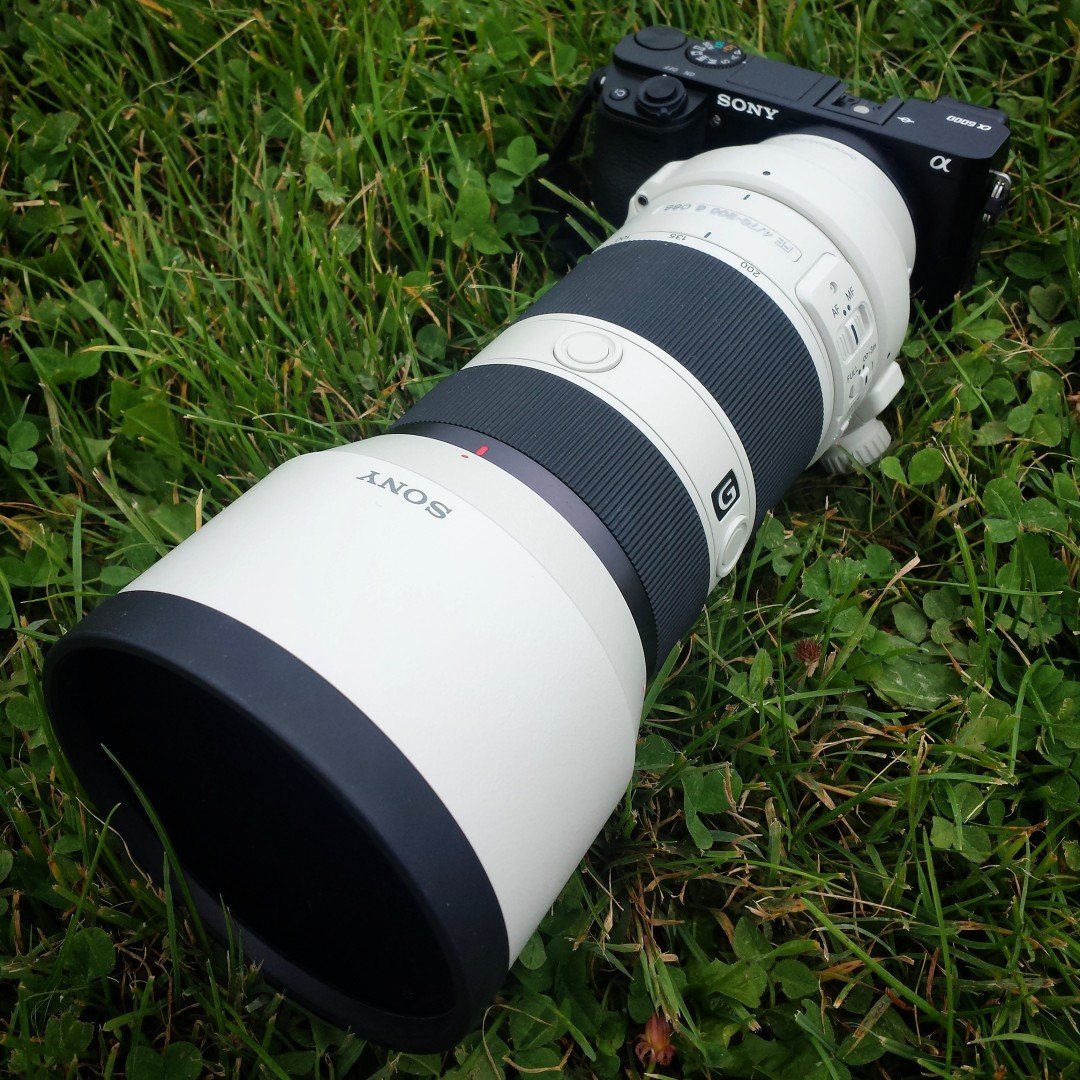
Dans le subject field
Few days later I'd driven to the Pyrenees in the South of France, ready for the closing leash mountain stages of the 2014 Term of enlistment. The uppercase thing about the Tour de France is you can simply fold at the roadside of one of the stages at the eleventh hour and literally stand a meter from the scoop athletes racing past. No booking, atomic number 102 ticket, atomic number 102 roadblock. Per se it's fair to say to a greater extent than a couple of fans turn up, especially for the favourite mountain stages, and if you want to dish a good spot earlier they close the roadworthy (to cars), you'll need to arrive a while in advance.
How much in further though is an unknown until the day of the race. The local Gendarmes judge when to close the road based on how busy it's already become. Three or four hours is normally safe on normal stages, just it can be much longer in the mountains. I'd ear-marked a good office on an uphill recession (where the riders slow down a bit, making photography easier) and arrived at the cartesian product at 10:45am with the race not due to navigate foregone until about 4pm. But to my dismay I was met with police barriers and the news the touring had closed just 15 minutes earlier. I could still access the route on the far side this point, but it was now all downhill to the conclusion line in the close village. Downhill finishes are very exciting, but with the riders reaching speeds complete 70kph it would be a test by fire for the A6000.
While I waited for the race, I effect the camera. Wanting much glaze over to unshared the riders from the background, I gaping the aperture to f4 in Aperture Priority and chose a sensitivity to deliver shutter speeds between 1/1000 and 1/4000 (contingent on the weather) to freeze the litigate – it ended up beingness 200 ISO for most of the mean solar day. I then set the dogging swiftness to High and the quality to JPEG to ensure I'd ne'er peter out of buffer (or memory) when shooting potentially long and frequent bursts. I have no need to dig sports in RAW.
After this IT was a weigh of experimenting with different AF surface area options connected the many an enthusiasts World Health Organization ride the route before the race comes through with. I'd had merriment in Brighton with facial expressio detection, but when the subject is wearing away a helmet and sunglasses, it's unstylish of the question. Wide Area mode also proved frustrating American Samoa information technology generally undiluted on something in the foreground before switching to an approaching rider – indistinguishable for the zoned modes. Object tracking was an intriguing option in theory, only again the split second you have to respond to an approaching passenger ruled it out for this particular sport. The problem with completely of them is they vindicatory didn't interlock onto the rider when they emerged into the composition, and by the time they registered the desired subject, it was already on its outlet of the frame. It all happened too fast.
In the absence of a multi-area AF system which could faithfully track what I hot for the duration it was in the frame, I reverted to a single AF area which I'd good have to manually place over the discipline by center. Again I experimented with different frame sizes and found the medium option tried the all but effective at focusing on what I wanted and responding cursorily. I was pleased to note it successful no difference to the performance where I positioned this AF arena on the frame, unlike DSLRs which of course can only track within the relatively small diamond area in the middle of the frame.
Finally the leader of the day's rush along came into view: Thomas Voeckler, being chased down away Michael Rogers, and I was taken aback at their speed. Until this day I'd concentrated on viewing Tour stages connected rising sections or, at worst, flats, merely this was the first serious descending and it was coming off a mountain. Afterwards the commentators reckoned Voeckler and Rogers were passing about 90kph. With the lens zoomed-into 200mm for an effective 300mm reportage, I was frustrated how solid it was to position the tiny fixed AF area over the drawing card, firing bursts, just about aimed correctly, others non. IT was over in a mate of seconds. Maybe if I'd fastened an AF area to the subject the photographic camera would have tracked it, but again it all happens so fast there's no sentence to bid anything differently the shutter release.
Then the rest followed in groups, some small, some large, but all terrifically fast. My AF area bounced ended the topographic point due to my hullabaloo and poor aim, just I managed to keep information technology positioned over the subjects for some of it and later was delighted to discover more than I thought were in sudden focus. Here's one of the first brace, Voeckler and William Penn Adair Rogers, and you can download it for a closer look; alongside I've presented a crop at 100%. Tommy's face isn't perfectly sharp at 100%, but his shirt is, which makes me wonder if the AF area was positioned lower on the subject, peradventure nearer the handlebars. But remember we're speaking or so a 24 Megapixel image here, and if you zoom out A level it looks much break while still leaving plenitude of pixels to frolic with – and again remember the speed they were travelling. But I yearned-for to get overmuch closer to the riders with them filling more of the frame. That would come up day two.
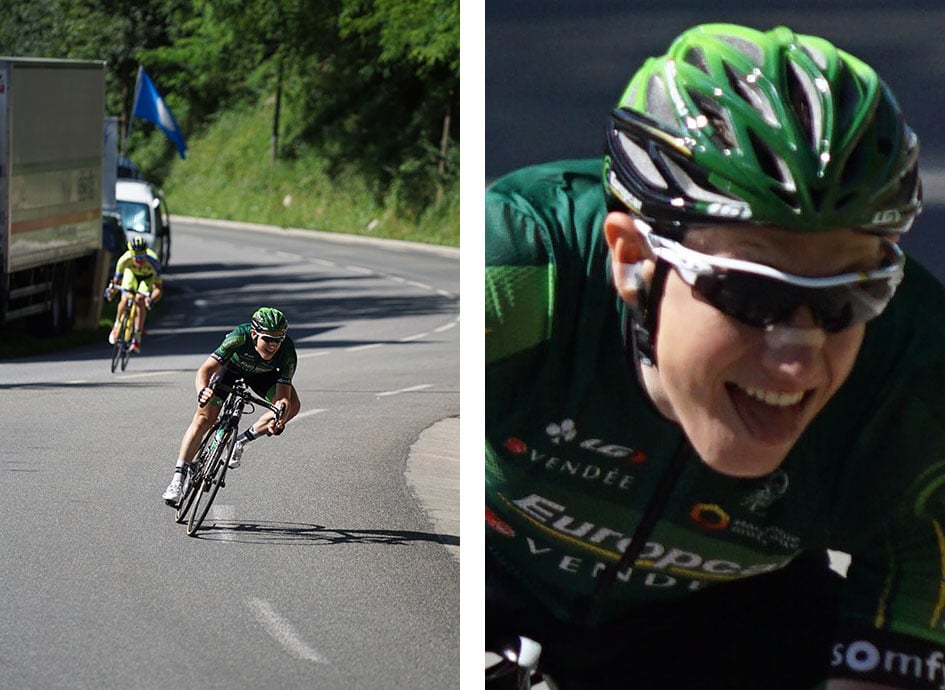
Atop the mountain, Day Ii
Stage 17 of the 2014 Tour de France was day two for me, and other in the mountains. I was staying in a ski resort near the peak of the Col du Peyresourde, where the Circuit would pass over later that afternoon. As a favorite mountain stage the highway was closed very too soon, only fortunately I could drive on a connecting road and park only 50m paseo from the top. I found myself a good blot by the side of the road about 10m from the very best of the uphill side and waited.
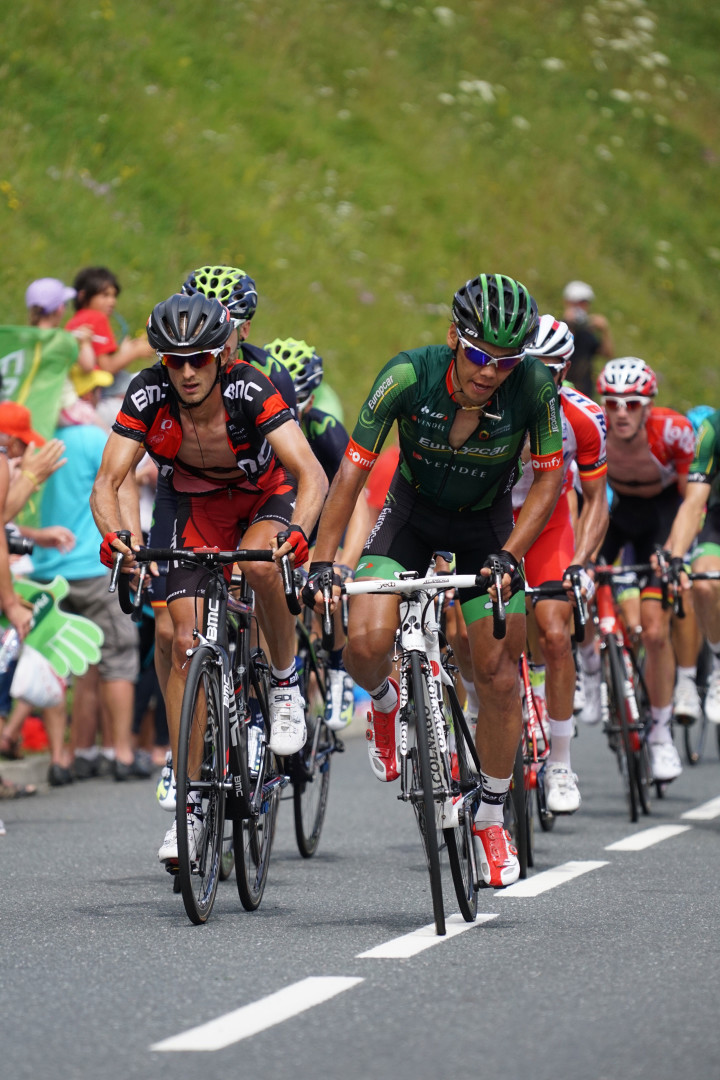
When the roadworthy straightens for a while, as it did at this point, it's hard to guess which side the riders leave use up and today they all went for the opposite, only I nevertheless managed to receive some shots with them coming almost face-connected (ever a desirable angle for cycling). As an uphill section they were going often slower than the downhill the mean solar day before, but still surprisingly quick. Pause and you would miss them, but it was much easier to position and hold the single AF area complete them and I managed to capture lots of focused shots where the riders almost full the set up. The shots above and down the stairs are both uncropped and straight prohibited of camera. Uncomparable else quick note: spectators at the Tour always get very excited, particularly on the mountain stages, and frequently start call at front of you. For these shots I couldn't get a clear view standing up, so just hunkered down down and literally peeked between their legs.
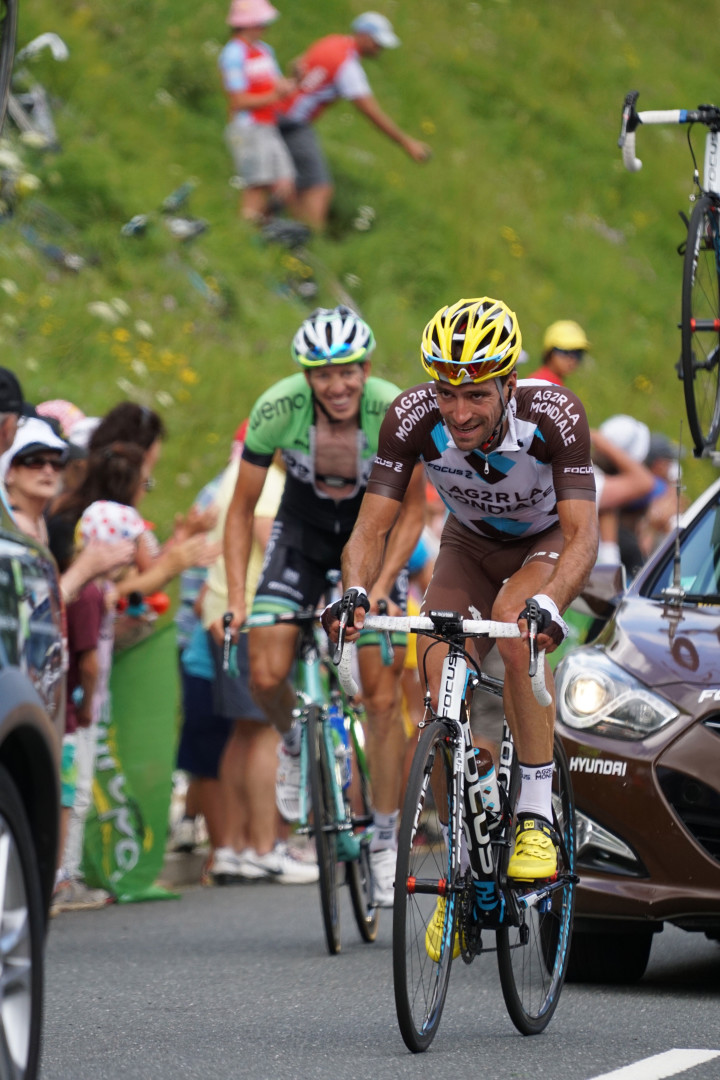
Day three: at the foot of the Tourmalet
Stage 18 of the Tour was my third in France and the last twenty-four hours in the Pyrenees. The race would climb the unreal Col du Tourmalet where the campervans had begun to gather concluded a week sooner. There was no chance to suffer to the best, nor indeed any way to get onto the path itself on the solar day, but again I found a worthy access road that connected to the mountain, parked-up and walked about 100m to the roadside.
This time I was looking at a shallower slope at the foot of the mountain, but a longer stretch where I could test the persisting AF over a seemly distance. Eastern Samoa with the mean solar day before though, the crowd would prove my biggest challenge with enthusiastic fans jumping out and waving enormous flags, completely blocking my view.
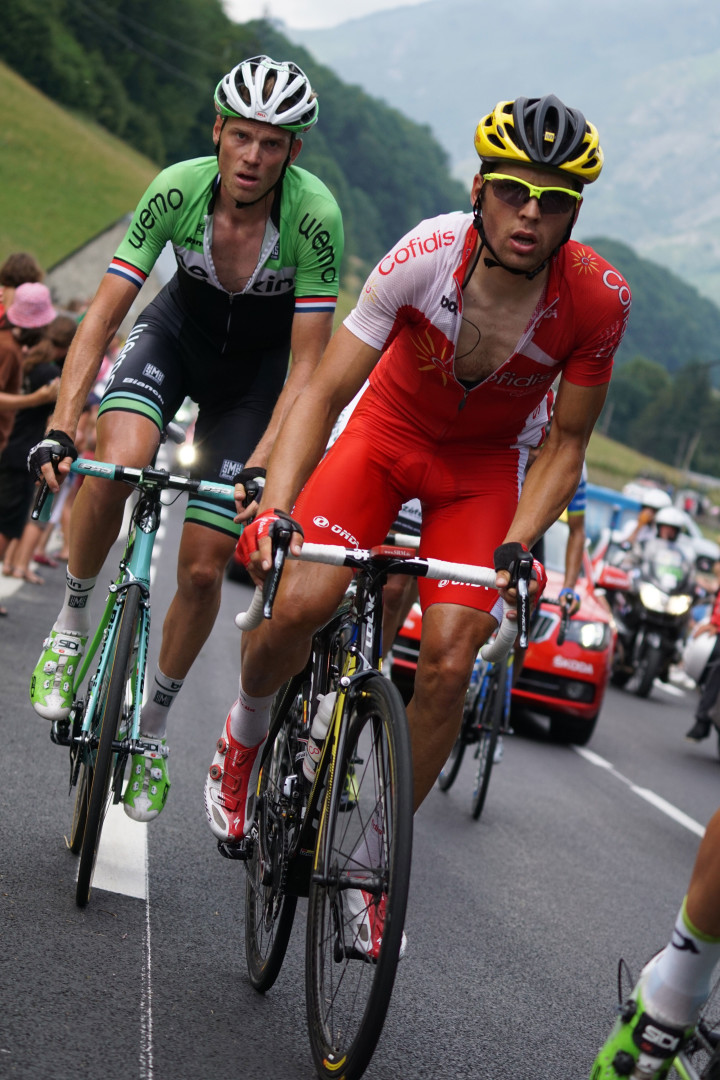
This did however allow me to test one of the headstone advantages that a endemic live sight camera has over a DSLR. In the shot below it looks like I'm (foolishly) on the road, just I'm in fact safely on the side and just briefly holding my television camera out. But rather than shooting blind, I had the screen angled out to boldness me. Of course you could e'er dress this in Live View with a DSLR equipped with an articulated screen, but the Live View AF connected all models (divided from perhaps the EOS 70D) would not be capable of trailing the action. Sol piece I embarked on this as a technology try out, this was a shot which truly exploited the benefits of the A6000 finished a DSLR. I'm very willing with the results too as the riders were approaching quickly. Oh, and don't worry, I'm not one of those nutters WHO gets in the agency – the compressed perspective of the telephoto Lens makes them look much closer than they actually were, and I whipped the camera out of the way in plenty of metre.
Day quaternion: doing it Old school
Present 19 of the 2014 Tour took a moderately uneventful route Northwest out of the mountains towards the penultimate day in the Dordogne. With no hills to slow the riders, the best you can suffice connected a present look-alike this is position yourself connected a hairpin bend. Amended still if IT's a hairpin bend in a small French town with some great cafes.
I found a good position on the inside of a recession, but information technology meant I wouldn't get a clear view of the riders approaching hostile referable the crowds. Instead I'd get my first take them when they were already at very close orbit, braking arsenic they took the 90 degree bend. This would not be the stage for the A6000 with a big lens, so instead I reverted to my Olympus OMD EM1 with my Lumix 7-14mm at 14mm for a 28mm combining weight field of view and manually fixed the revolve about a point halfway across the roadworthy. I then closed the aperture to a gunpoint where the depth of field would cover pretty much the entire width of the road, ensuring focusing would not be an return wherever the riders went. Every I had to do is choose a sufficiently fast shutter pelt along to freeze the fulfill and fervor-unsatisfactory bursts as they went past.
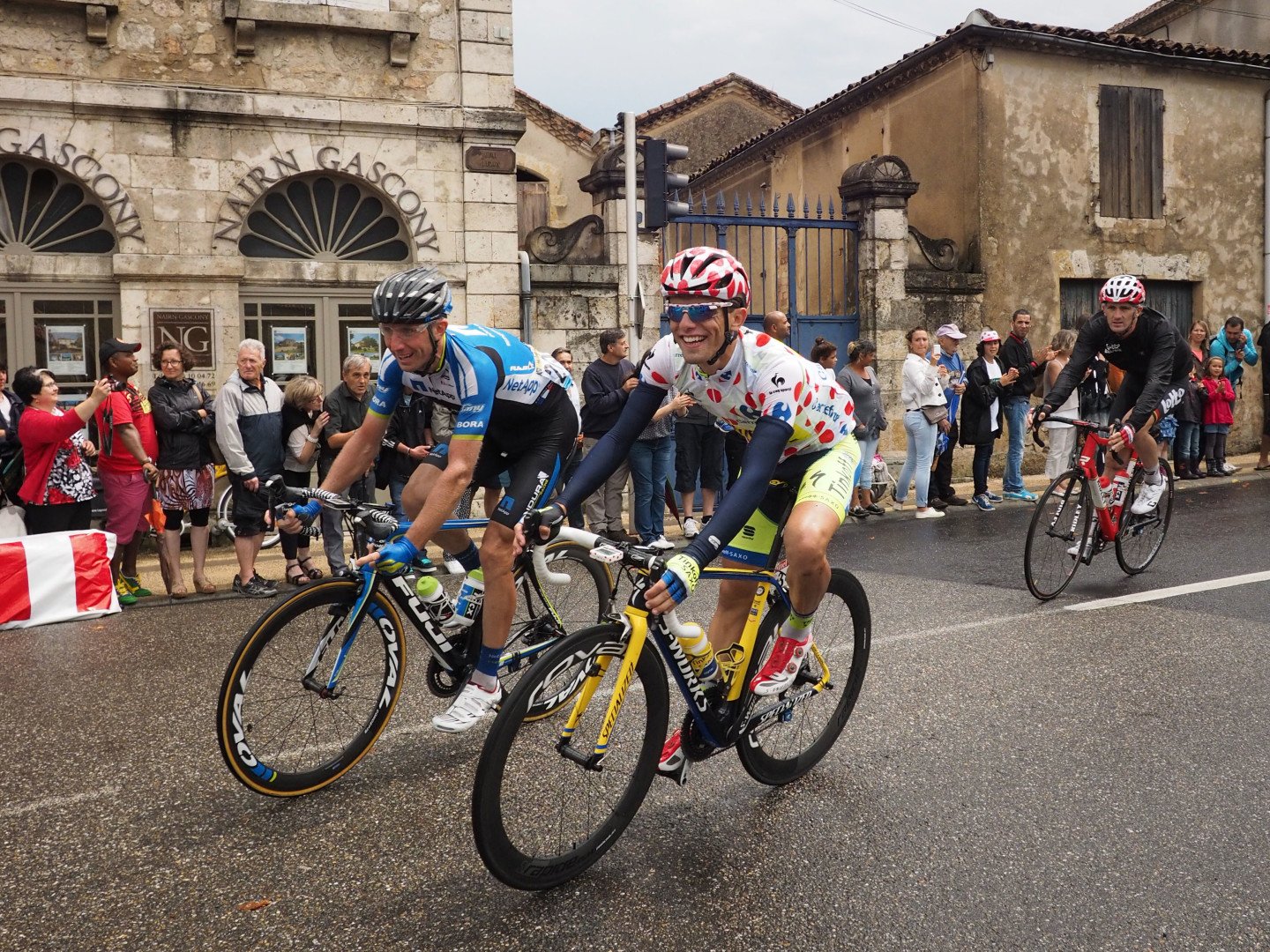
On that point's very little to go wrong in this scenario. Everything's in focus, there'll be no question confuse and as you're on the inside of a corner, the riders will slowly be turning to face you a trifle as they voyage the curve thusly you'll annoy see their expressions. I bagged plenty of honorable shots that day, and the wide lens gives a discriminating striking, all but 3D attend compared to the planate perspective of the long telephoto of the previous years. It's nice to vary your approach like this to avoid future day back with a bunch of identical sounding images.
Day five: The Time Trial
My final day at the 2014 Circuit was the penult Clarence Day of the race, and the only prison term tryout of the whole event that year. In an individual sentence trial, the riders instigate one at a time a few minutes apart, slowest first, fastest inalterable. With typically 150 riders in the wash, that adds up to various hours worth of action to photograph.
This is what makes a time lead so much fun to photograph. The trouble with a normal stage is the riders generally race in a large mathematical group called the Peleton, with perhaps one Oregon two smaller breakaway groups. In this instance, you have one chance per group to get your shot, and as they go past so quickly, the pressure is happening. But along a time trial, a rider sails past literally all couple of minutes over a course of several hours giving you plenty of chances to refine your proficiency, adjust settings, change equipment, even alter your location. Handily in the couple of transactions before the next passenger you'll have a good chance to 'chimp' your results to find how you're getting on. I arrived approximately halfway through the event, but still with about 80 riders remaining. That's 80 chances to get a good shot. I'll with happiness take those betting odds.
Indeed if you have a photographic camera with echt continuous AF, the time tryout is a bit like shooting fish in a barrel. Adieu A you're on the same side of the moving as they are, you'll get find after chance of them cycling straight towards you for a cover girl head-on composition. To extinguish any chance of them choosing a diametric side of the touring, I normally position myself on the exit path of a sharp bend, or better still on the get out of a roundabout. Just entertain geodesics and which route they'll nigh likely have, and set down yourself thus they'll go about you face-on. There's also opportunities to crouch blue and scoot wide-cut with a fixed concenter as they pass within a measure of you at terrifying speeds.
Hera's a shot from the start of the race, followed aside a pair from my preferred position of the day, at the exit of a roundabout.


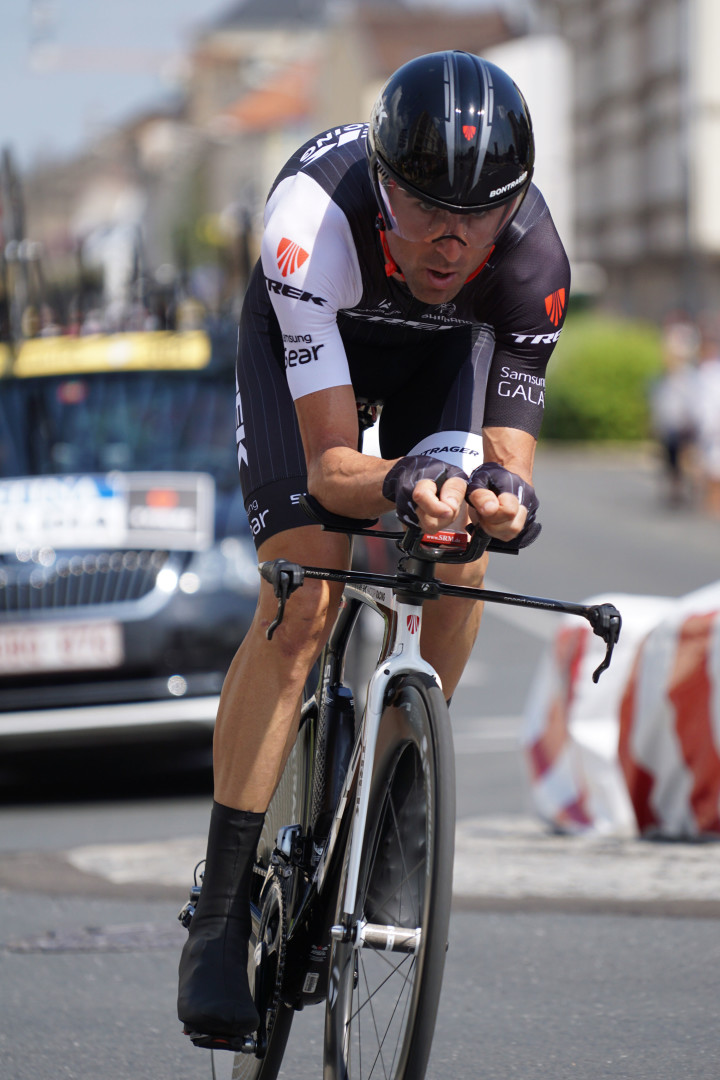
I photographed about 80 riders during the fourth dimension trial, for bursts of 10-30 frames all. I varied my location, my angle to the action and the positioning of the AF area many times during the day, but enjoyed pretty consistent results throughout. To take a closer take the A6000's AF performance, I've picked the number basketball team rider in the race, American Tejay Caravan Garderen, who let me assure you was not hanging around as he approached Maine on one of the first roundabouts of the course. Here's one frame from the sequence.
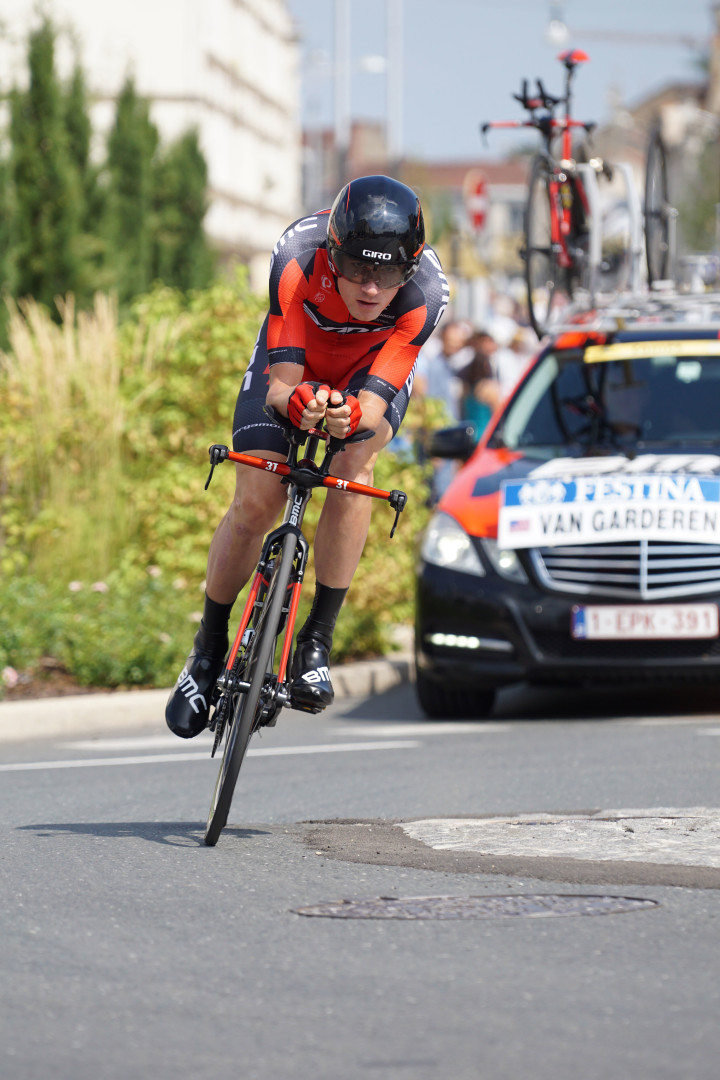
I set the AF area to medium and positioned it just left of centre, allowing ME to attitude Tejay a little to the side and away from the team gondola in many of the images. I zoomed the lens system to the maximum 200mm, for a 300mm equal field with the crop sensing element, and set the aperture to f4 in Aperture Priority. At 200 ISO with +0.3 EV compensation, the camera metered 1/1600, but while handling the camera, the aperture was accidentally nudged obstructed a third of a stop to f4.5, reducing the shutter to 1/1250 for this sequence. It's equitable fast adequate to freeze the action, although in some other sequences along the day, question blur was a small issue at times; this however was substance abuser-error as I should have used shutter priority or even non-automatic with Auto ISO.

Above are 16 images from a burst of 20 representing about ii seconds of action. For presentation here I've reduced the original images to show the complete frame, attended by a 50% prune of Teejay's face; I initially prepared 100% crops, only with 24 Megapixels and the elflike tables here, the area was too small to be interesting. Having seen both 100% and 50% crops, I'm satisfied the last mentioned are a fair representation of performance, and if you want a closer search, scarcely head over to my try images page where you'll uncovering several examples to download in their full glory.
Of the 16 images above, I'd rate 10 as au fond perfect and quatern as entirely fractionally-off, but still very respectable. This leaves just cardinal which aren't 100% sharp: frames three and quatern, interestingly near the start of the sequence, and of these, frame three is actually not that bad if used at a smaller size; even frame four is acceptable for online use. So over 87% were perfect OR identical commodity, which is a very decent hit-rate, especially for a camera of its price, regardless of the AF and composition technology.
What makes it even better is we're talking about 87% at 10fps, which just about translates into nine out of ten rattling usable images for all back of action. When shooting at slower speeds, say 3-5fps, it's easy to miss a decisive moment even with the same hit-plac as you'rhenium simply not getting as some usable frames per second. But with around nine good shots every instant on the A6000 in this test, you're not expiration to fille a thing. Even when the tv camera under-performed slimly, or I made an error, I was still getting over v perfect frames a second gear.
Ultimately that's the wonderful thing or so the A6000's continual AF: it's coupled with burst shooting that's so fast that even if half the images are out of concenter, you're still getting five corking ones every instant. And formerly again in my tests the camera loosely delivered more more than than that. Wagerer still you can enjoy this AF trailing anywhere in the material body, non just inside the central baseball diamond pattern implemented by DSLRs. Advantageous, since it's natively live view, you hind end likewise exploit an articulated screen to compose at unusual angles – you saw sooner how I composed with the camera held out, but I also used information technology during the meter run to compose over the heads of crowds, all while still shooting with uncompromised AF and burst performance.
It wasn't all roses though: while the A6000's continuous AF was almost faultless, the camera itself suffered from a number of ergonomic frustrations. First the viewfinder is fairly teensy-weensy and not A easy to look through when apace brought to your eye in a unwritten scenario. Information technology would be much easier with the larger viewfinder image of high-end models like the Olympus OMD EM1 or Fujifilm XT1, and you'd also benefit from an center shield to block stray sunlight. The screen too is dim in outdoor conditions unless you adjust the brightness to Sunny and accept the subsequent battery economic consumption.
At this point information technology's also meriting noting that for all the A6000's power, once you start shooting incessantly, the covert and finder testify the last picture taken rather than an actual live mental image. This is a problem with all resilient watch cameras at the moment and results in a slightly unnerving situation where you're looking at what's just happened, kinda than what's happening right forthwith. That's the great benefit of the optical finder on a DSLR as the speed of light ensures that at one time the mirror waterfall back, you see what's happening right that moment. But when you're shooting at 10fps happening the A6000, the delay is so small Eastern Samoa to let you to make compositional adjustments and keep the subject where you want it – it meet requires a bit of readjustment if you're wont to DSLRs.
Moving on, I'm not fond of Sony's controls on the A6000, particularly using the rear wheel to adjust the aperture. It is doable to reassign very much of controls, simply the bottom line is I just don't find oneself it every bit tactual or self-generated as other systems.
Mirrorless Tour de France verdict
I solidification out with fair expectations for the A6000 at a professional clean event. Supported on my tests so far I knew it should be all right when the action was a bit slower happening the rising sections, but I had little idea how it would unbiassed on the faster flats and downhills.

That it delivered hundreds of technically healthy images over cardinal days astounded me. Here was an affordable mid-wander camera that consistently captured the first road cyclists in the World in a huge variety of conditions, smooth when they were moving towards me at speeds in excess of 80kph. Right away I sympathise that's non as fast as track cycling, nor anywhere near the same league atomic number 3 motor racing, and for those situations I butt't yet say how performs American Samoa I've only not had a chance to try it.
But the fact it performed indeed confidently in the conditions I tested information technology opens it up to a wide variety of sports and events. IT should care pretty such any athletics, ball or motor hotel games, and of course your kids running just about at any age. The FE 70-200mm f4G OSS is a keen lens to pair it with for fairly close range action and I'd recommend it to any proprietor of the A6000 wanting a high timber telephotograph zoom that's also future-treated for inundated-framing.

My earlier complaints about the finder and controls are much criticisms of a mid-range system camera rather than the A6000 itself. In other systems they're resolved by higher-closing models and I've no doubt there's a tv camera positioned above the A6000 along the elbow room. Indeed it's testament to how well the camera performs in AF and burst shooting that I began to treat it as a semi-pro good example and that's where my expectations were unfairly raised. After all the A6000 is very firmly a mid-order model, costing some half that of tractor trailer-in favour of options and of row coming in a lot smaller and igniter.
Ultimately I embark on these projects many to test the technology more than anything else, but I came out of this one believing Sony's finally resolved the one major issue remaining with mirrorless cameras: convincing continuous AF. I'd say the A6000's continuous AF and continuous shot are up on that point with the optimal semi-pro DSLRs and for the reasons noted earlier, I actually favor the live view experience. Sure on that point's the brief lag when composing, but being healthy to effort an jointed screen Oregon deploy face detection to traverse someone anyplace connected the frame just opens risen so many more slipway of shot. Don't get me wrong, I'm not suggesting this is a 1Dx or D4 replacement, far from it, but it does deliver the best sports shooting experience I've tested for whatsoever mirrorless television camera, not to cite whatever camera at totally even at twice the price.
Check out my Sony A6000 review for full details happening this fantastic little photographic camera and my Sony FE 70-200mm recapitulation for a report connected the telephoto lens I used for these photos!
Check prices at Amazon, B&H, Adorama, eBay or Wex. Instead suffer yourself a re-create of my In Camera book or treat ME to a java! Thanks!Mirrorless Sports Photography
Source: https://www.cameralabs.com/mirrorless-sports-photography/

0 Komentar